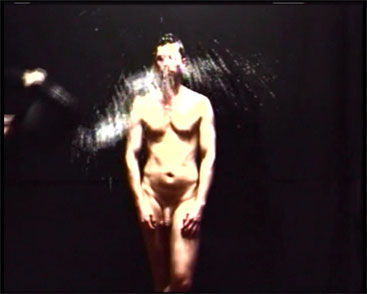
Born in 1963 in Culiacan, Sinaloa (MX)
Lives and works in Madrid (ES)

2004
Video, colour, sound
Durée : 1'
Year of Purchase: 2004
In dim light a man’s young athletic torso can only just be made out. Then all of a sudden this ideal beauty is splashed violently with literally bucketfuls of water. A terrible baptism, for this is the water of the dead that comes at regular intervals upsetting this body, and this short video. For, as with all her works, Teresa Margolles draws her raw material from the Mexico City morgue where she has been working since 1990. Greasy with the fat of autopsied bodies and the memory of these mostly anonymous corpses, and of their often violent deaths, this water ought to end up in the city sewers. But the Mexican artist recovers it and gives shape to it; in the exhibition space it can become soap bubbles, a spray jet or water steadily dripping from the ceiling and forming an odd heap of grease. No critical distancing is possible, nor any protection … The work submerges and penetrates the visitor, short-circuiting any reflection. He or she takes it full in the face, suddenly confronted with death shorn of its mysticism and ritual. In this regard, the video El Bano may be seen as typifying Teresa Margolles’ entire work: a mise en abîme of a body engaged both mentally and physically in this painful confrontation with the taboo of death. ‘My gesture in throwing the water at the young man is for me a way of throwing this water in art history’s face,’1 the artist explains.
Starting out from a much more baroque aesthetics, Teresa Margolles founded the Semefo group (the name means ‘forensic department’) in 1990, at the time fearlessly exhibiting even body parts. But she gradually moved on in her installations, sculptures and photographs to much more minimalist forms, being aware of the need to avoid appealing to the spectacular in a society that was ‘already submerged in horror pictures.’2 In this sense, she comes closer to her fellow artist and friend Santiago Sierra, who also works with Minimalism to reveal its ideological nature. Today, the question of death instils itself rather than imposing itself in Margolles’ works. Seemingly harmless enough, and yet absolutely loaded, they carry a macabre implication, and invite visitors to a meditation that is just as political as it is metaphysical. A mortuary for her is not a subject for morbid curiosity, but very much a direct way to knowing and understanding the world. In these last remnants of life, it is all the pain of her country and her continent that she is carrying and collecting, its flagrant social inequalities which she sees every day at the morgue, because it is just so true how ‘rich and poor do not die the same way,’3 its unrestrained violence that the politicians studiously ignore. With this denunciatory rage that makes each of her works a scream in the art lover’s untroubled face, she mixes in the heartbreak of Georges Bataille and the pessimism of Cioran. But then, why should art be allowed to just sit back?
Emmanuelle Lequeux
1 Teresa Margolles, Frac Lorraine, Metz, 2005.
2 Interview with the author, Beaux-Arts magazine, Paris, May 2005.
3 Ibid.